oil level FIAT QUBO 2017 1.G Owners Manual
[x] Cancel search | Manufacturer: FIAT, Model Year: 2017, Model line: QUBO, Model: FIAT QUBO 2017 1.GPages: 260, PDF Size: 4.74 MB
Page 132 of 260
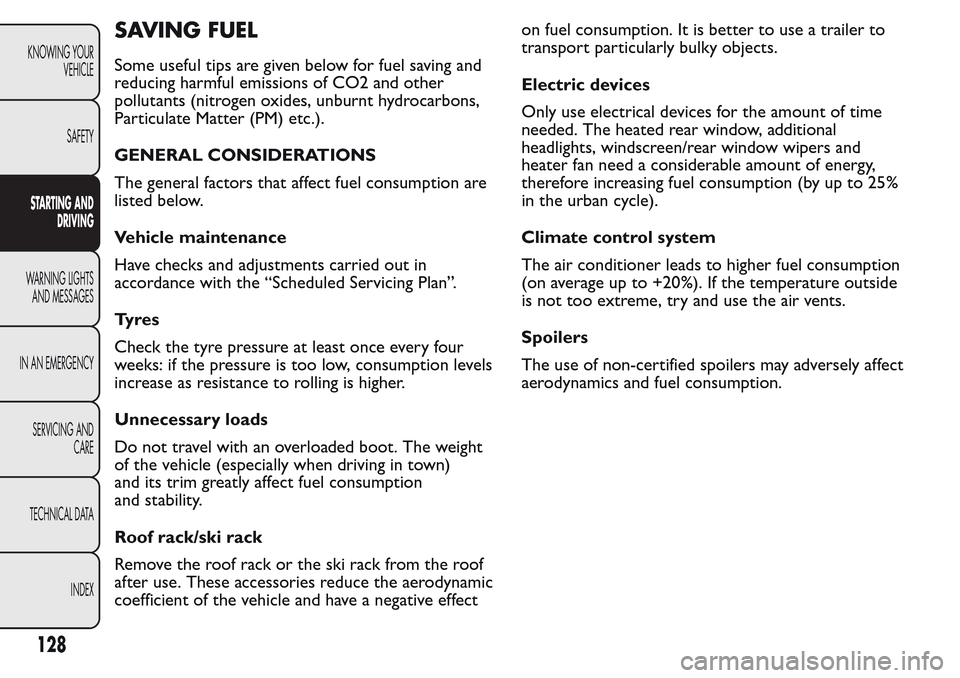
SAVING FUEL
Some useful tips are given below for fuel saving and
reducing harmful emissions of CO2 and other
pollutants (nitrogen oxides, unburnt hydrocarbons,
Particulate Matter (PM) etc.).
GENERAL CONSIDERATIONS
The general factors that affect fuel consumption are
listed below.
Vehicle maintenance
Have checks and adjustments carried out in
accordance with the “Scheduled Servicing Plan”.
Ty r e s
Check the tyre pressure at least once every four
weeks: if the pressure is too low, consumption levels
increase as resistance to rolling is higher.
Unnecessary loads
Do not travel with an overloaded boot. The weight
of the vehicle (especially when driving in town)
and its trim greatly affect fuel consumption
and stability.
Roof rack/ski rack
Remove the roof rack or the ski rack from the roof
after use. These accessories reduce the aerodynamic
coefficient of the vehicle and have a negative effecton fuel consumption. It is better to use a trailer to
transport particularly bulky objects.
Electric devices
Only use electrical devices for the amount of time
needed. The heated rear window, additional
headlights, windscreen/rear window wipers and
heater fan need a considerable amount of energy,
therefore increasing fuel consumption (by up to 25%
in the urban cycle).
Climate control system
The air conditioner leads to higher fuel consumption
(on average up to +20%). If the temperature outside
is not too extreme, try and use the air vents.
Spoilers
The use of non-certified spoilers may adversely affect
aerodynamics and fuel consumption.
128
KNOWING YOUR
VEHICLE
SAFETY
STARTING AND
DRIVING
WARNING LIGHTS
AND MESSAGES
IN AN EMERGENCY
SERVICING AND
CARE
TECHNICAL DATA
INDEX
Page 142 of 260
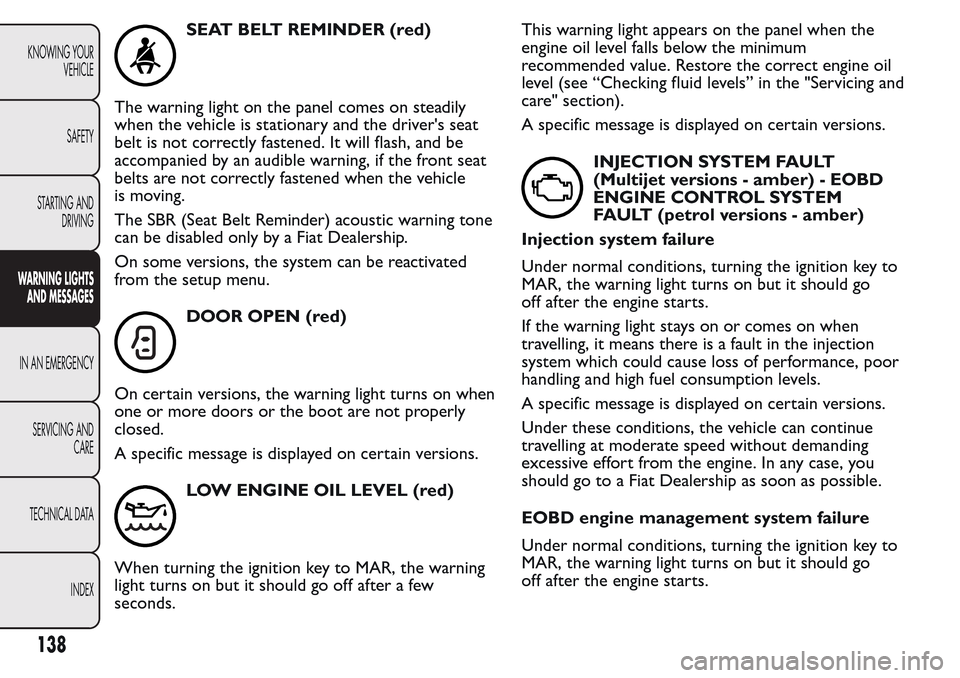
SEAT BELT REMINDER (red)
The warning light on the panel comes on steadily
when the vehicle is stationary and the driver's seat
belt is not correctly fastened. It will flash, and be
accompanied by an audible warning, if the front seat
belts are not correctly fastened when the vehicle
is moving.
The SBR (Seat Belt Reminder) acoustic warning tone
can be disabled only by a Fiat Dealership.
On some versions, the system can be reactivated
from the setup menu.
DOOR OPEN (red)
On certain versions, the warning light turns on when
one or more doors or the boot are not properly
closed.
A specific message is displayed on certain versions.
LOW ENGINE OIL LEVEL (red)
When turning the ignition key to MAR, the warning
light turns on but it should go off after a few
seconds.This warning light appears on the panel when the
engine oil level falls below the minimum
recommended value. Restore the correct engine oil
level (see “Checking fluid levels” in the "Servicing and
care" section).
A specific message is displayed on certain versions.
INJECTION SYSTEM FAULT
(Multijet versions - amber) - EOBD
ENGINE CONTROL SYSTEM
FAULT (petrol versions - amber)
Injection system failure
Under normal conditions, turning the ignition key to
MAR, the warning light turns on but it should go
off after the engine starts.
If the warning light stays on or comes on when
travelling, it means there is a fault in the injection
system which could cause loss of performance, poor
handling and high fuel consumption levels.
A specific message is displayed on certain versions.
Under these conditions, the vehicle can continue
travelling at moderate speed without demanding
excessive effort from the engine. In any case, you
should go to a Fiat Dealership as soon as possible.
EOBD engine management system failure
Under normal conditions, turning the ignition key to
MAR, the warning light turns on but it should go
off after the engine starts.
138
KNOWING YOUR
VEHICLE
SAFETY
STARTING AND
DRIVING
WARNING LIGHTS
AND MESSAGES
IN AN EMERGENCY
SERVICING AND
CARE
TECHNICAL DATA
INDEX
Page 188 of 260
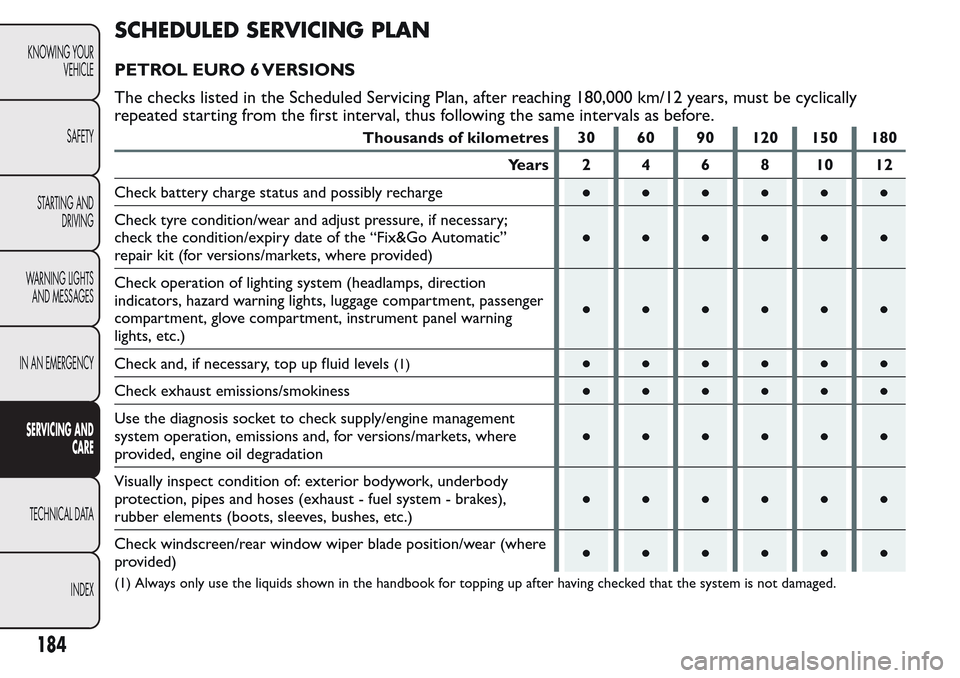
SCHEDULED SERVICING PLAN
PETROL EURO 6 VERSIONS
The checks listed in the Scheduled Servicing Plan, after reaching 180,000 km/12 years, must be cyclically
repeated starting from the first interval, thus following the same intervals as before.
Thousands of kilometres 30 60 90 120 150 180
Years 2 4 6 8 10 12
Check battery charge status and possibly recharge●●●●●●
Check tyre condition/wear and adjust pressure, if necessary;
check the condition/expiry date of the “Fix&Go Automatic”
repair kit (for versions/markets, where provided)●●●●●●
Check operation of lighting system (headlamps, direction
indicators, hazard warning lights, luggage compartment, passenger
compartment, glove compartment, instrument panel warning
lights, etc.)●●●●●●
Check and, if necessary, top up fluid levels
(1)●●●●●●
Check exhaust emissions/smokiness●●●●●●
Use the diagnosis socket to check supply/engine management
system operation, emissions and, for versions/markets, where
provided, engine oil degradation●●●●●●
Visually inspect condition of: exterior bodywork, underbody
protection, pipes and hoses (exhaust - fuel system - brakes),
rubber elements (boots, sleeves, bushes, etc.)●●●●●●
Check windscreen/rear window wiper blade position/wear (where
provided)●●●●●●
(1) Always only use the liquids shown in the handbook for topping up after having checked that the system is not damaged.
184
KNOWING YOUR
VEHICLE
SAFETY
STARTING AND
DRIVING
WARNING LIGHTS
AND MESSAGES
IN AN EMERGENCY
SERVICING AND
CARE
TECHNICAL DATA
INDEX
Page 191 of 260
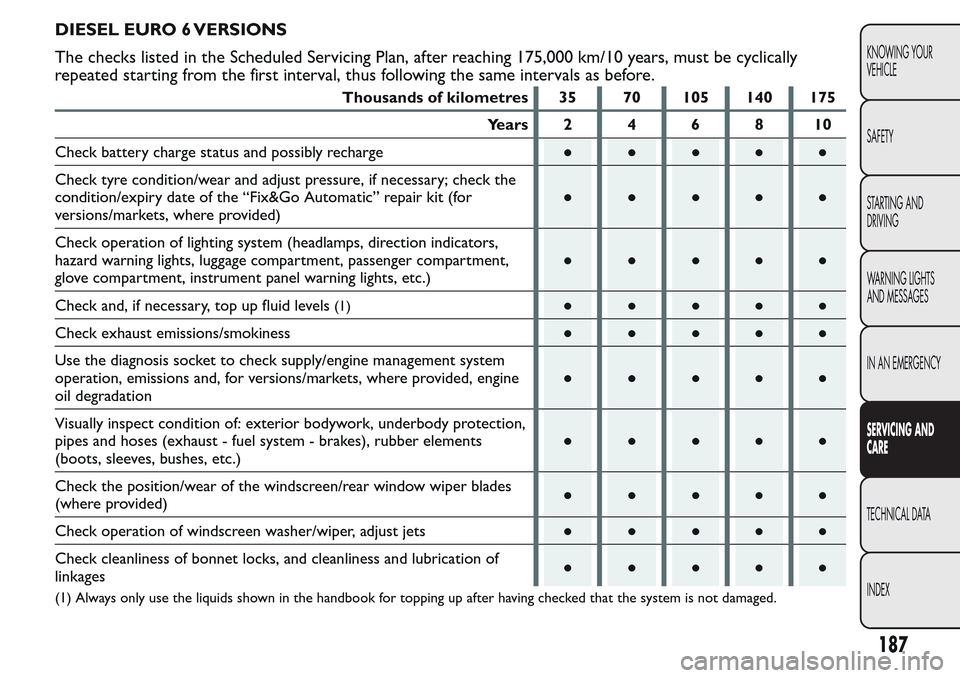
DIESEL EURO 6 VERSIONS
The checks listed in the Scheduled Servicing Plan, after reaching 175,000 km/10 years, must be cyclically
repeated starting from the first interval, thus following the same intervals as before.
Thousands of kilometres 35 70 105 140 175
Years 2 4 6 8 10
Check battery charge status and possibly recharge●●●●●
Check tyre condition/wear and adjust pressure, if necessary; check the
condition/expiry date of the “Fix&Go Automatic” repair kit (for
versions/markets, where provided)●●●●●
Check operation of lighting system (headlamps, direction indicators,
hazard warning lights, luggage compartment, passenger compartment,
glove compartment, instrument panel warning lights, etc.)●●●●●
Check and, if necessary, top up fluid levels
(1)●●●●●
Check exhaust emissions/smokiness●●●●●
Use the diagnosis socket to check supply/engine management system
operation, emissions and, for versions/markets, where provided, engine
oil degradation●●●●●
Visually inspect condition of: exterior bodywork, underbody protection,
pipes and hoses (exhaust - fuel system - brakes), rubber elements
(boots, sleeves, bushes, etc.)●●●●●
Check the position/wear of the windscreen/rear window wiper blades
(where provided)●●●●●
Check operation of windscreen washer/wiper, adjust jets●●●●●
Check cleanliness of bonnet locks, and cleanliness and lubrication of
linkages●●●●●
(1) Always only use the liquids shown in the handbook for topping up after having checked that the system is not damaged.
187
KNOWING YOUR
VEHICLE
SAFETY
STARTING AND
DRIVING
WARNING LIGHTS
AND MESSAGES
IN AN EMERGENCY
SERVICING AND
CARE
TECHNICAL DATA
INDEX
Page 193 of 260
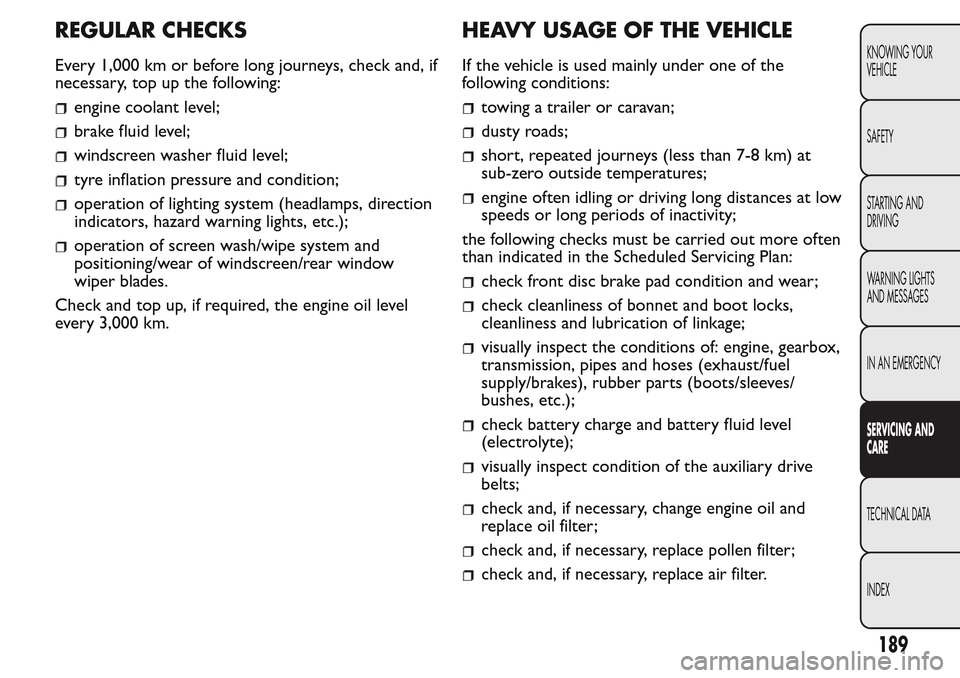
REGULAR CHECKS
Every 1,000 km or before long journeys, check and, if
necessary, top up the following:
engine coolant level;
brake fluid level;
windscreen washer fluid level;
tyre inflation pressure and condition;
operation of lighting system (headlamps, direction
indicators, hazard warning lights, etc.);
operation of screen wash/wipe system and
positioning/wear of windscreen/rear window
wiper blades.
Check and top up, if required, the engine oil level
every 3,000 km.
HEAVY USAGE OF THE VEHICLE
If the vehicle is used mainly under one of the
following conditions:
towing a trailer or caravan;
dusty roads;
short, repeated journeys (less than 7-8 km) at
sub-zero outside temperatures;
engine often idling or driving long distances at low
speeds or long periods of inactivity;
the following checks must be carried out more often
than indicated in the Scheduled Servicing Plan:
check front disc brake pad condition and wear;
check cleanliness of bonnet and boot locks,
cleanliness and lubrication of linkage;
visually inspect the conditions of: engine, gearbox,
transmission, pipes and hoses (exhaust/fuel
supply/brakes), rubber parts (boots/sleeves/
bushes, etc.);
check battery charge and battery fluid level
(electrolyte);
visually inspect condition of the auxiliary drive
belts;
check and, if necessary, change engine oil and
replace oil filter;
check and, if necessary, replace pollen filter;
check and, if necessary, replace air filter.
189
KNOWING YOUR
VEHICLE
SAFETY
STARTING AND
DRIVING
WARNING LIGHTS
AND MESSAGES
IN AN EMERGENCY
SERVICING AND
CARE
TECHNICAL DATA
INDEX
Page 194 of 260
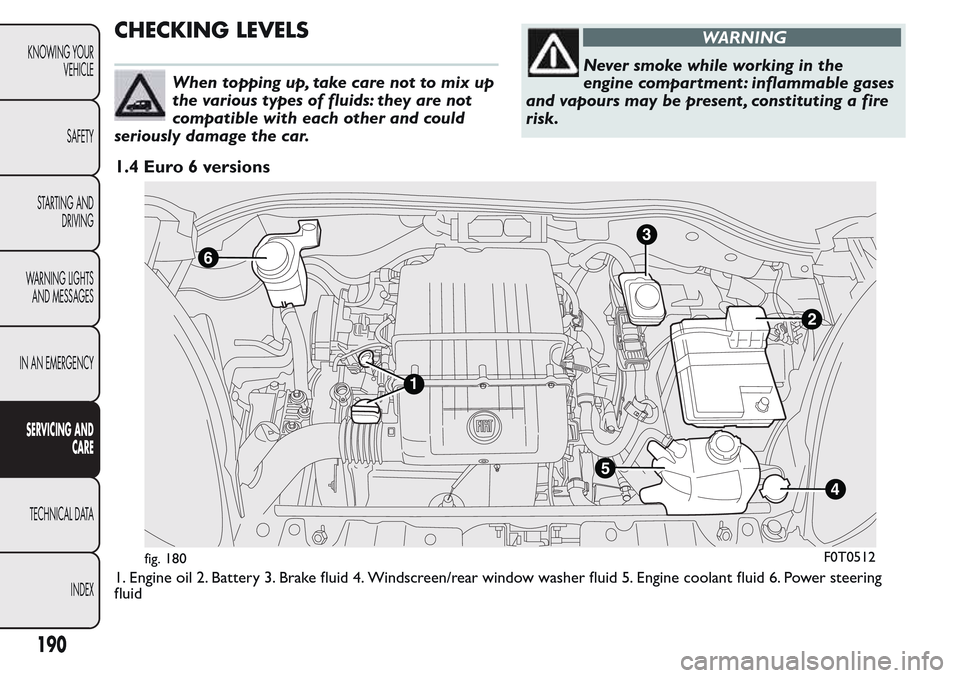
CHECKING LEVELS
When topping up, take care not to mix up
the various types of fluids: they are not
compatible with each other and could
seriously damage the car.
WARNING
Never smoke while working in the
engine compar tment : inflammable gases
and vapours may be present , constituting a fire
risk.
1.4 Euro 6 versions
1. Engine oil 2. Battery 3. Brake fluid 4. Windscreen/rear window washer fluid 5. Engine coolant fluid 6. Power steering
fluid
3
2
4
6
1
5
fig. 180F0T0512
190
KNOWING YOUR
VEHICLE
SAFETY
STARTING AND
DRIVING
WARNING LIGHTS
AND MESSAGES
IN AN EMERGENCY
SERVICING AND
CARE
TECHNICAL DATA
INDEX
Page 196 of 260
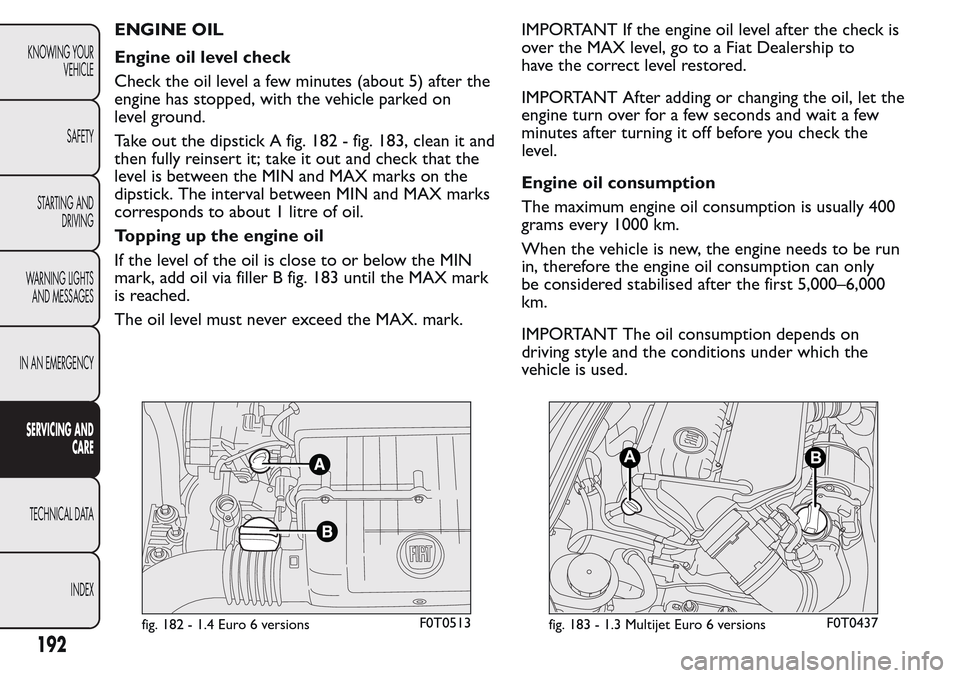
ENGINE OIL
Engine oil level check
Check the oil level a few minutes (about 5) after the
engine has stopped, with the vehicle parked on
level ground.
Take out the dipstick A fig. 182 - fig. 183, clean it and
then fully reinsert it; take it out and check that the
level is between the MIN and MAX marks on the
dipstick. The interval between MIN and MAX marks
corresponds to about 1 litre of oil.
Topping up the engine oil
If the level of the oil is close to or below the MIN
mark, add oil via filler B fig. 183 until the MAX mark
is reached.
The oil level must never exceed the MAX. mark.IMPORTANT If the engine oil level after the check is
over the MAX level, go to a Fiat Dealership to
have the correct level restored.
IMPORTANT After adding or changing the oil, let the
engine turn over for a few seconds and wait a few
minutes after turning it off before you check the
level.
Engine oil consumption
The maximum engine oil consumption is usually 400
grams every 1000 km.
When the vehicle is new, the engine needs to be run
in, therefore the engine oil consumption can only
be considered stabilised after the first 5,000–6,000
km.
IMPORTANT The oil consumption depends on
driving style and the conditions under which the
vehicle is used.
fig. 182 - 1.4 Euro 6 versionsF0T0513
AB
fig. 183 - 1.3 Multijet Euro 6 versionsF0T0437
192
KNOWING YOUR
VEHICLE
SAFETY
STARTING AND
DRIVING
WARNING LIGHTS
AND MESSAGES
IN AN EMERGENCY
SERVICING AND
CARE
TECHNICAL DATA
INDEX
Page 197 of 260
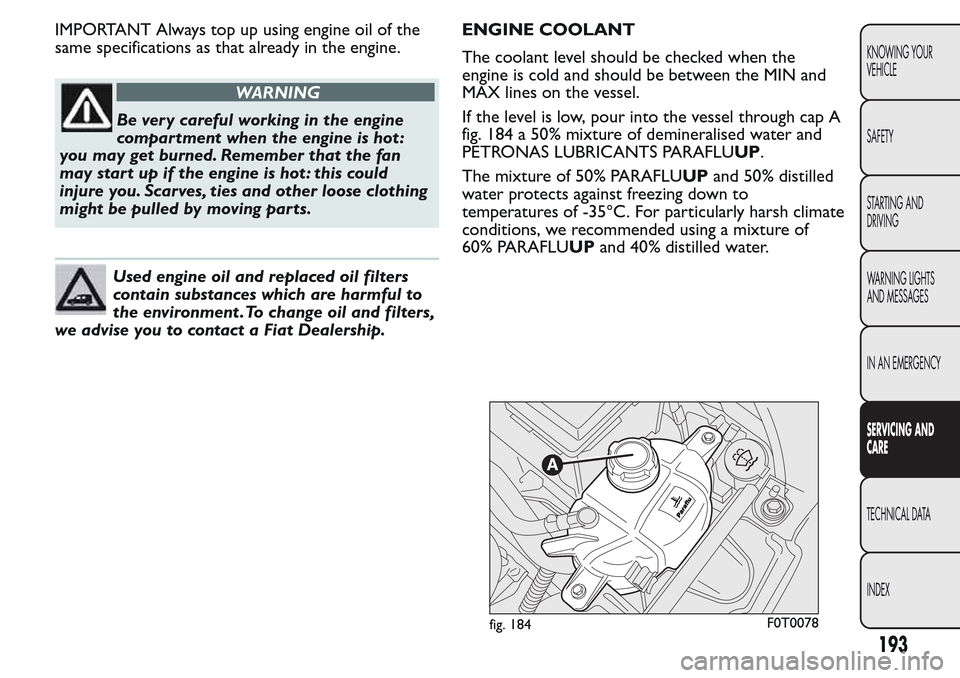
IMPORTANT Always top up using engine oil of the
same specifications as that already in the engine.
WARNING
Be very careful working in the engine
compartment when the engine is hot :
you may get burned. Remember that the fan
may start up if the engine is hot : this could
injure you. Scarves, ties and other loose clothing
might be pulled by moving parts.
Used engine oil and replaced oil filters
contain substances which are harmful to
the environment .To change oil and filters,
we advise you to contact a Fiat Dealership.ENGINE COOLANT
The coolant level should be checked when the
engine is cold and should be between the MIN and
MAX lines on the vessel.
If the level is low, pour into the vessel through cap A
fig. 184 a 50% mixture of demineralised water and
PETRONAS LUBRICANTS PARAFLUUP.
The mixture of 50% PARAFLUUPand 50% distilled
water protects against freezing down to
temperatures of -35°C. For particularly harsh climate
conditions, we recommended using a mixture of
60% PARAFLUUPand 40% distilled water.
fig. 184F0T0078
193
KNOWING YOUR
VEHICLE
SAFETY
STARTING AND
DRIVING
WARNING LIGHTS
AND MESSAGES
IN AN EMERGENCY
SERVICING AND
CARE
TECHNICAL DATA
INDEX
Page 200 of 260
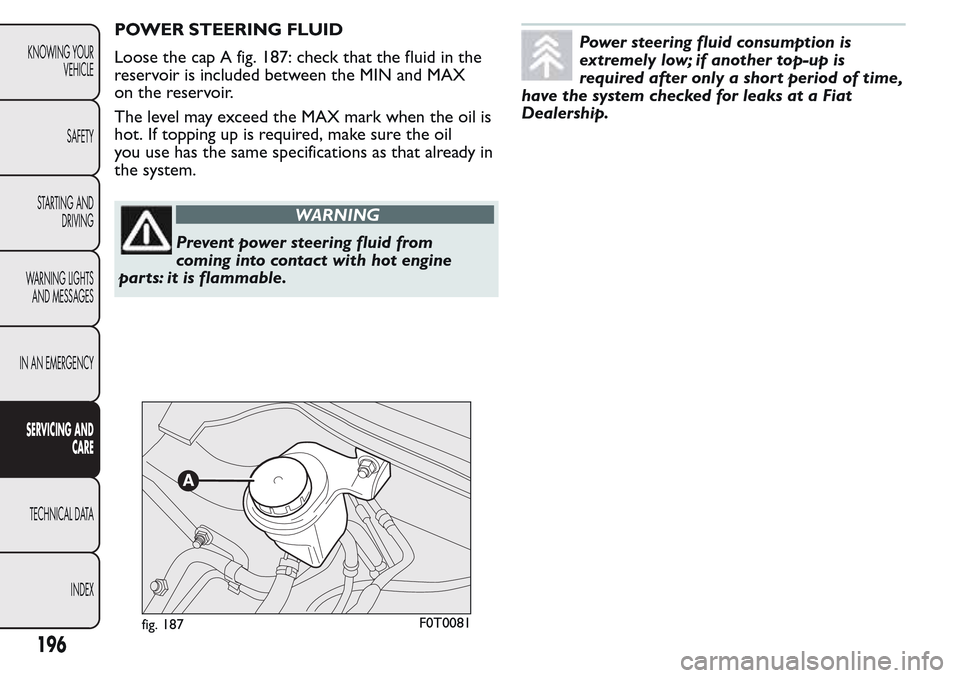
POWER STEERING FLUID
Loose the cap A fig. 187: check that the fluid in the
reservoir is included between the MIN and MAX
on the reservoir.
The level may exceed the MAX mark when the oil is
hot. If topping up is required, make sure the oil
you use has the same specifications as that already in
the system.
WARNING
Prevent power steering fluid from
coming into contact with hot engine
parts: it is flammable.
Power steering fluid consumption is
extremely low; if another top-up is
required after only a short period of time,
have the system checked for leaks at a Fiat
Dealership.
fig. 187F0T0081
196
KNOWING YOUR
VEHICLE
SAFETY
STARTING AND
DRIVING
WARNING LIGHTS
AND MESSAGES
IN AN EMERGENCY
SERVICING AND
CARE
TECHNICAL DATA
INDEX
Page 256 of 260
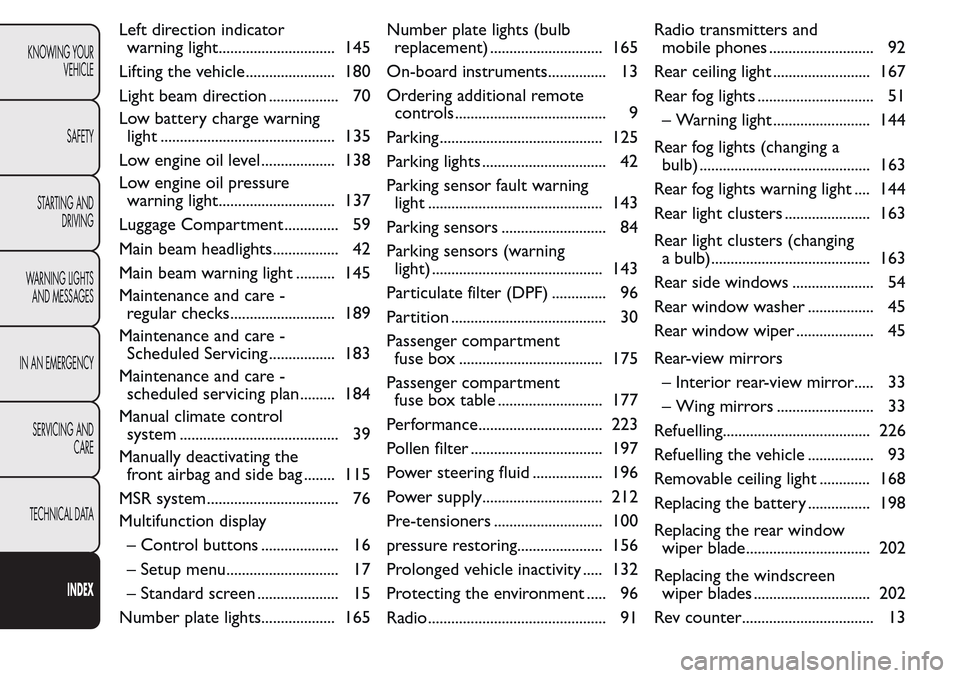
Left direction indicator
warning light.............................. 145
Lifting the vehicle....................... 180
Light beam direction .................. 70
Low battery charge warning
light ............................................. 135
Low engine oil level ................... 138
Low engine oil pressure
warning light.............................. 137
Luggage Compartment.............. 59
Main beam headlights................. 42
Main beam warning light .......... 145
Maintenance and care -
regular checks........................... 189
Maintenance and care -
Scheduled Servicing ................. 183
Maintenance and care -
scheduled servicing plan......... 184
Manual climate control
system ......................................... 39
Manually deactivating the
front airbag and side bag ........ 115
MSR system.................................. 76
Multifunction display
– Control buttons .................... 16
– Setup menu............................. 17
– Standard screen ..................... 15
Number plate lights................... 165Number plate lights (bulb
replacement) ............................. 165
On-board instruments............... 13
Ordering additional remote
controls ....................................... 9
Parking .......................................... 125
Parking lights ................................ 42
Parking sensor fault warning
light ............................................. 143
Parking sensors ........................... 84
Parking sensors (warning
light) ............................................ 143
Particulate filter (DPF) .............. 96
Partition ........................................ 30
Passenger compartment
fuse box ..................................... 175
Passenger compartment
fuse box table ........................... 177
Performance................................ 223
Pollen filter .................................. 197
Power steering fluid .................. 196
Power supply............................... 212
Pre-tensioners ............................ 100
pressure restoring...................... 156
Prolonged vehicle inactivity ..... 132
Protecting the environment ..... 96
Radio.............................................. 91Radio transmitters and
mobile phones ........................... 92
Rear ceiling light ......................... 167
Rear fog lights .............................. 51
– Warning light ......................... 144
Rear fog lights (changing a
bulb) ............................................ 163
Rear fog lights warning light .... 144
Rear light clusters ...................... 163
Rear light clusters (changing
a bulb)......................................... 163
Rear side windows ..................... 54
Rear window washer ................. 45
Rear window wiper .................... 45
Rear-view mirrors
– Interior rear-view mirror..... 33
– Wing mirrors ......................... 33
Refuelling...................................... 226
Refuelling the vehicle ................. 93
Removable ceiling light ............. 168
Replacing the battery ................ 198
Replacing the rear window
wiper blade................................ 202
Replacing the windscreen
wiper blades .............................. 202
Rev counter.................................. 13
KNOWING YOUR
VEHICLE
SAFETY
STARTING AND
DRIVING
WARNING LIGHTS
AND MESSAGES
IN AN EMERGENCY
SERVICING AND
CARE
TECHNICAL DATA
INDEX